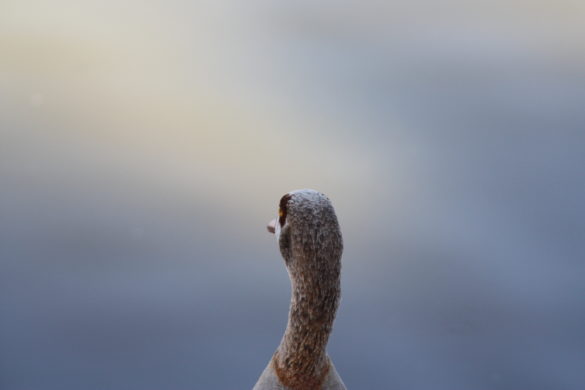
A Canadian Goose, staring into the great abyss that is his home. Does he show Theory of Mind?
Photo by Benjamin Minch.By Benjamin Minch, Staff Writer
When the majority of humans view the animal kingdom, they see inferior beings that are less smart than themselves. This sort of thinking makes humans feel unique and special, but it is also a complete lie that humanity has been telling itself for centuries. Animals are in fact, beings of superior intelligence than we give them credit for. Gorillas can take IQ tests and score high, wolves can create a unique and highly complex social structure and bats can tell where the position of everything in the world is located just by using their ears. The most prominent test of intelligence in animals however, is Theory of Mind (ToM), a concept believed to be unique only to humans up until the 21st century.
ToM, as defined by dictionary.com, is “the ability to attribute mental states—beliefs, intents, desires, pretending, knowledge, etc.—to oneself and others and to understand that others have beliefs, desires, intentions, and perspectives that are different from one’s own.” To simplify this, it is the idea that one can understand their place in the world and that other people have differing thoughts from you. It is a common idea that proves that an organism is self-aware of itself and its surroundings.
ToM, as coined in 1978 by Premack and Woodruff, was originally a failed experiment. Many scientists attempted to test out this new hypothesis, but were unable find the results they were looking for. This however, was misdirected research because they were studying animals from a human perspective.
The study of research rebounded in the early 2000s, when chimpanzees were the subject of many different studies relating to intelligence. Chimpanzees were discovered to be extremely intelligent. When presented with two tubes of food, one clear and one opaque, they chose the opaque one when a human was watching them. They chose the opaque one rather than the clear one because they had been previously scolded for stealing food, but they stole it nonetheless because they knew that the human couldn’t see the contents inside of the opaque tube.
As one can see from the chimpanzee experiment, the methods and experiments used to test ToM are highly complex and not very repeatable. This is why this type of science is so controversial and highly debated. One test however, that is almost universally accepted as a representation of ToM, is the mirror test.
The mirror test is conducted in order to see whether or not animals can distinguish themselves in the mirror. In this test of self-recognition, an animal is propped up facing a mirror to see what it will do. Variables introduced vary, but many of them consist of irritating the animal by putting something on them that they must get off. Whether or not the animal uses the mirror to assist them will ultimately decide whether or not they show signs of self-recognition.
Many different animals have passed this test such as elephants, gorillas, chimpanzees and bonobos, but at the same time, many have failed, including dogs. Although this test isn’t a definite test of self-awareness, it is a good step towards the discovery of it in animals.
Overall, it does appear that animals show ToM and self-awareness and there is too much evidence for me to dismiss that this is the case. Animals, like us, are intelligent beings in their own way and will still be intelligent even without humanized ToM tests. They are truly brilliant organisms.





